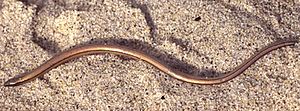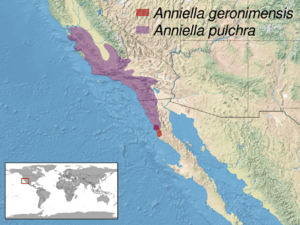California legless lizard facts for kids
Quick facts for kids California legless lizard |
|
|---|---|
 |
|
| Conservation status | |
| Scientific classification | |
| Genus: |
Anniella
|
| Species: |
pulchra
|
 |
|
| Range of Anniella pulchra (sensu lato) in purple | |
The California legless lizard (Anniella pulchra) is a super cool reptile that looks a lot like a snake! But don't be fooled, it's actually a type of lizard that doesn't have legs. These amazing creatures spend most of their lives burrowing underground.
Contents
What Does the California Legless Lizard Look Like?
These lizards are usually about 18 centimeters (7 inches) long, not counting their tail. They have tiny, smooth scales. Their top side is often silvery, and their belly is usually yellow.
Sometimes, you might see black or dark brown ones. These darker lizards are found in Monterey County, California. For a while, people thought they were a different kind of legless lizard!
How Are Legless Lizards Classified?
Scientists used to think there were two main types of California legless lizards. One was the silvery kind, and the other was the black kind. They called them different subspecies.
However, today, scientists believe the black lizards are just a color variation. It's like how some people have blonde hair and others have brown hair! More recently, in 2013, scientists decided to split A. pulchra into five different species. This means there are now more types of legless lizards to learn about!
Where Do Legless Lizards Live?
These lizards love to live in loose, sandy soil. You can often find them in sand dunes along the coast. They also like areas with lots of leaf litter.
They live all the way from Contra Costa County in northern California down to Baja California in Mexico. However, you might not find them everywhere in between. They need moisture to help them shed their skin. If it's too dry, they can have trouble seeing and eating. This can make it hard for them to survive.
What Do Legless Lizards Eat?
California legless lizards are carnivores, which means they eat other small creatures. Their diet mainly includes beetles and their larvae. They also enjoy munching on termites, ants, and spiders.
How Do Legless Lizards Reproduce?
It's hard to tell the difference between male and female legless lizards just by looking at them. Males are usually a little bit smaller than females.
Female legless lizards are special because they are ovoviviparous. This means their eggs hatch inside their body, and then they give birth to live young. They probably have babies between September and November. A mother legless lizard usually has 1 to 4 babies at a time. The baby lizards look just like smaller versions of their parents!



